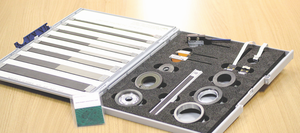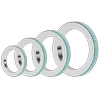Magnetic Measurement
Featured Product from BOGEN Magnetics GmbH

Magnetic measuring offers numerous advantages over other positioning and measuring methods: it allows measuring at a distance, in dirty environments with high accuracy.
A typical measuring solution consists of a measuring head with sensor and a magnetic linear or rotary scale (pulse generator).
For measurement, the magnetic properties of a scale are evaluated. For this purpose, the scale is defined with a pattern of magnetic north and south poles to form a highly accurate scale. BOGEN can encode linear and rotary scales using a patented special process with freely Xable magnetic patterns: single-track or multi-track, incremental or absolute. With a magnetic viewer, this magnetic information can be made visible on a scale. It shows the boundaries between the north and south poles.
Magnetic measurement is contactless. The distance between sensor and linear or rotary scale depends on the pole length. As a rule of thumb, the distance between the scale and sensor can be half a pole pitch (length of a single pole). When using a scale with 5 mm pole pitch, this means that the distance between the sensor and the scale should be less than 2.5 mm. This distance can be air, but any paramagnetic material could be used, for example most liquids.
No visual contact is required for magnetic measurement. However, in many industrial applications, dirt, dust, or liquid droplets accumulate on the scale. However, the scale can still be read regardless of these disturbances, since only the magnetic field is relevant to the sensor.
The challenge in reading with high accuracy is to create a very precise magnetic pattern, i.e. to set the boundaries between the north and south poles exactly at the ideal position. For a scale with 2 mm pole pitch, i.e. the length of a single pole is 2 mm each, it must be ensured that there is a pole boundary exactly every 2 mm. A measuring accuracy of 3 µm can be achieved.
The magnetic field of a scale remains unchanged over time. It can only be changed if a stronger magnetic field touches the scale in contact.
Measuring head with magnetic sensor
The sensing head is a sensing head device with integrated electronics to measure the magnetic information from a magnetic scale and convert it into a signal that can be used in the connected electronics. There are different types of readheads. They are characterized by the sensor used, the output signal (digital or analog) and the amount of signal processing in the readhead.
The key element of a sensing head is the sensor. Different types of sensor technology are used to read the magnetic pattern: Hall sensors and magneto-resistive sensors. These sensors convert magnetic information into an electrical signal that can be used for motion control or other electronic control.
Different types of sensor technology are used for different tasks.






